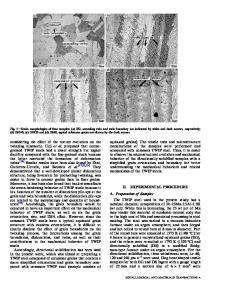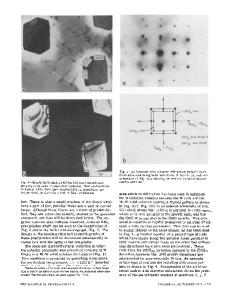Characterization of Dendritic Microstructure, Intermetallic Phases, and Hardness of Directionally Solidified Al-Mg and A
- PDF / 3,600,126 Bytes
- 14 Pages / 593.972 x 792 pts Page_size
- 15 Downloads / 289 Views
reliability of aluminum alloys has allowed their application in several fields of industry. For example, the 5052 (Al-Mg-based alloys) and 6061 (AlSiMg-based alloys) ASTM series alloys are widely used to produce tubes and pipes by extrusion of ingots. The 6061 alloys are also used in breathing gas cylinders for scuba diving and for self-contained breathing apparatus or in the manufacture of manifold for gas distribution in the semiconductor industry. Aircraft fuel and oil lines, fuel tanks, and some marine applications require the 5052 alloy. In general, aluminum alloys have favorable characteristics such as good formability, weldability, machinability, reasonable corrosion resistance, and excellent castability.[1–6] The automotive industry has increased recently the production of aluminum alloy castings for engine blocks and cylinder heads.[7]
CRYSTOPHER BRITO, THIAGO A. COSTA, and TALITA A. VIDA, Ph.D. Students, FELIPE BERTELLI, Researcher, NOE´ CHEUNG and AMAURI GARCIA, Professors, are with the Department of Manufacturing and Materials Engineering, University of Campinas, UNICAMP, PO Box 6122, Campinas, SP 13083-970, Brazil. JOSE´ EDUARDO SPINELLI, Professor, is with the Department of Materials Engineering, Federal University of Sa˜o Carlos – UFSCar, Sa˜o Carlos, Sa˜o Paulo 13565-905, Brazil. Contact e-mail: [email protected] Manuscript submitted February 1, 2015. Article published online May 20, 2015 3342—VOLUME 46A, AUGUST 2015
Al-Mg alloys exhibit moderate-to-high strengths and toughness properties.[5] High corrosion resistance, especially to seawater and marine atmospheres, is the primary advantage of castings made of Al-Mg alloys. These alloys are suitable for welded assemblies and are often used in architectural and other decorative or building needs. Careful melting and pouring practices are needed to compensate for the greater oxidizing tendency of these alloys when molten. A very comprehensive study was developed by Liu and Kang[8] so that some effects of Mg alloying (2.46 to 11.07 wt pct Mg) and cooling rate could be assessed for binary Al-Mg alloys. According to these authors, the formation and growth of the eutectic structure were decisively influenced by the cooling conditions. The eutectic fraction (a-AI + Al8Mg5) was observed to increase with increasing cooling rate, which was varied from 0.008 to 167 K/ s. However, for cooling rates higher than 3.2 K/s, the average concentration of Mg in the second phase Al8Mg5 was shown to decrease gradually. The size of the eutectic phase decreased continuously from 1.0 to 167 K/s. Even though the eutectic phase was examined, a lack of discussion could be noted concerning the dendritic growth of the Al-Mg alloys examined. Al-Si alloys are being used to replace a number of ferrous alloys in the automotive, transportation, and aerospace industries.[9] According to Goulart et al.,[10] the dendritic arrangement of the Al-Si hypoeutectic alloy may affect significantly the ultimate tensile strength, ru. Under fast cooling conditions, the dendritic METALLURGICAL AND MATE
Data Loading...











